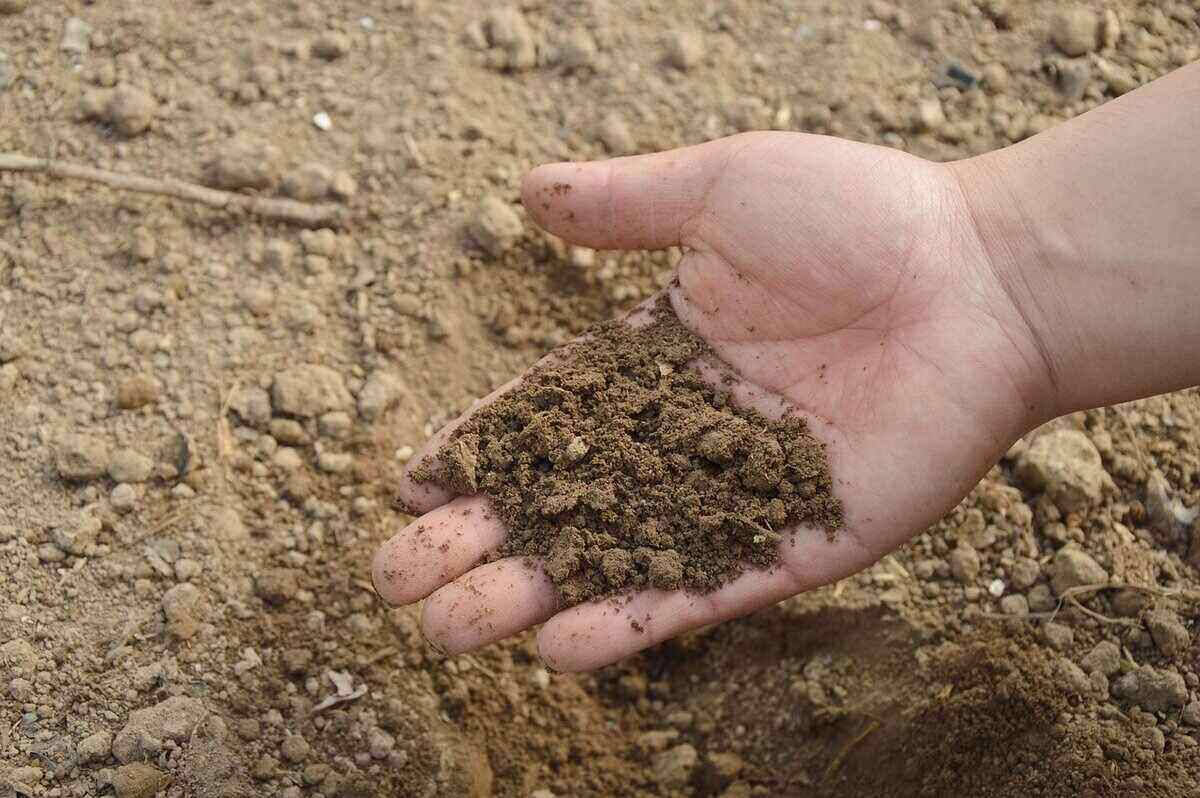
There are six different types of soil, each with its own advantages and disadvantages. Why do you need to know them? The success of your garden and even the grass on your lawn starts with your soil. The plants you grow, how you water and fertilize, what soil amendments you have to use – it all depends on the ground under your feet. If you have the wrong dirt for your plants, you can really soil your garden without knowing where the problem is.
This guide to soil types will tell you a little bit about each kind of soil, which plants grow best in each, how to identify your soil, and how to work with it.
6 Basic Soil Types
Soils are divided into six different types based on structure or texture. All soils are made of some combination of organic matter and rock particles. The size of the particles is what makes the different soil textures.
The following are the six basic soil textures, but the soil in your yard probably isn’t 100% one or the other. Most soils are a combination of two or more different textures. You might have sandy clay, clay loam, sandy silt, or any other combination of soil types.
1. Sandy Soil
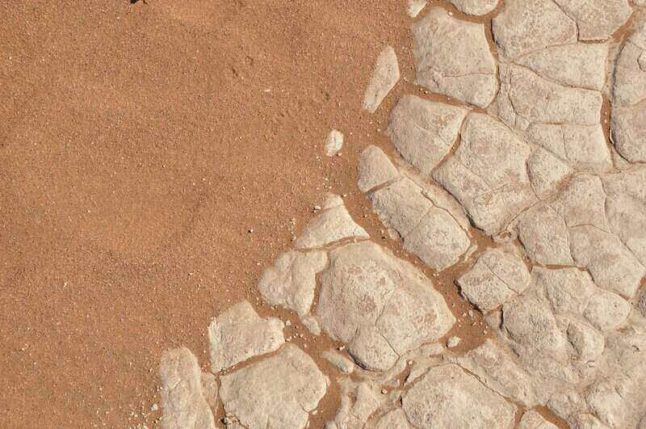
Sandy soils have large, coarse rock particles and a loose structure. They feel gritty when rubbed between your fingers. Because there’s so much space for air between the large soil particles, water and nutrients can move quickly and easily through these soils. This makes them dry and poor in nutrients.
Here’s what to expect when growing plants on sandy soil:
| Pros of Sandy Soils | Cons of Sandy Soils |
| ✓ Drains well ✓ Good aeration ✓ Easy to dig and cultivate ✓ Quick to warm up in spring, so plants start growing earlier | ✗ Can’t retain essential plant nutrients ✗ Dries out very quickly, especially in summer ✗ Tends to be a more acidic soil than the ideal range for most plants ✗ Quick to cool down in fall, so annual plants die earlier |
Best Plants for Sandy Soil
Garden soil rich in sand particles is more suitable for plants that deal with drought and love a loose soil texture. The best plants for landscaping a sandy yard include:
- Succulents
- Palms
- Yuccas
- Salvia
- Butterfly weed
Best Vegetables for Sandy Soil
If starting a vegetable garden in sandy soil, the best crops to go for are:
- Carrots
- Radishes
- Potatoes
- Beets
- Watermelons
- Herbs like rosemary and oregano.
Best Grasses for Sandy Soil
Dreaming of lush grass in your front yard? The best turf choices for sandy lawns are drought-resistant grass species like:
How to Water Sandy Soil
If the soil is very rich in sand, irrigate thrice a week with about 1/3 inch of water per session. With a bit more clay in the texture, go for a twice-a-week irrigation schedule, applying 1/2 inch of water each time.
Top Amendments for Sandy Soil
In order to amend sandy soil properly, focus on improving its nutrient and water-holding capacity. The best amendments to use are:
- Vermiculite or sphagnum peat improves moisture retention.
- Biochar helps the soil hold on nutrients.
- Organic matter (compost, manure, leaf mold, sawdust, grass clippings, etc.) enhances structure and enriches nutrient content.
2. Silty Soil
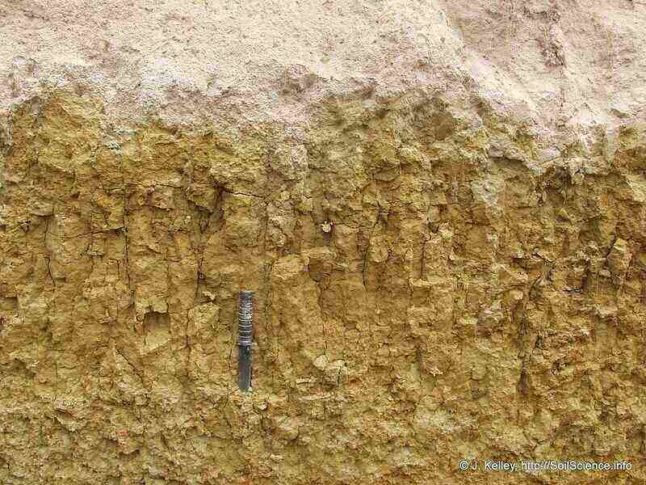
Silt particles are medium-sized, somewhere between coarse sand and fine clay. Silt soils have a soft and slippery texture that might remind you of soap. You’ll usually find this type of soil near rivers, lakes, ponds, and similar natural bodies of water.
| Pros of Silty Soil | Cons of Silty Soil |
| ✓ Good balance between retaining moisture and draining well ✓ Rich in nutrients for plants ✓ Soft and easy to cultivate | ✗ Prone to erosion ✗ Becomes compacted easily |
Best Plants for Silty Soil
Rich in nutrients and with good water retention, silt soil is an excellent environment for plant growth. Plants with shallow roots thrive in this type of garden soil, so it’s ideal for growing ornamental species like:
- Hardy geraniums
- Roses
- Butterfly bush
- Daffodils
- Hostas
Best Vegetables for Silty Soil
Some tasty vegetables fit for this kind of soil are:
- Lettuces
- Onions
- Broccoli
- Cabbage
Silty soil is also suitable for a Three Sisters garden, mixing corn, beans, and squash in the same space.
Best Grasses for Silty Soil
If you’re planning to sow a lawn on silty soil, consider:
They are the best grass types for silty ground.
How to Water Silty Soil
Silty soil holds water well, so irrigate deeply and less often. To avoid erosion, keep the water pressure low and cover the ground with mulch.
Top Amendments for Silty Soil
Silty soil’s main problem is the high risk of erosion. To improve this type of soil use:
- Groundcover plants and green manure to help keep the silt soil in place.
- Mulch to reduce erosion done by irrigation and rainwater.
- Organic matter enhances the soil’s ability to bind particles into larger pieces that hold water and nutrients better.
This type of soil is also prone to compaction, so reduce tilling and avoid foot traffic.
3. Clay Soil
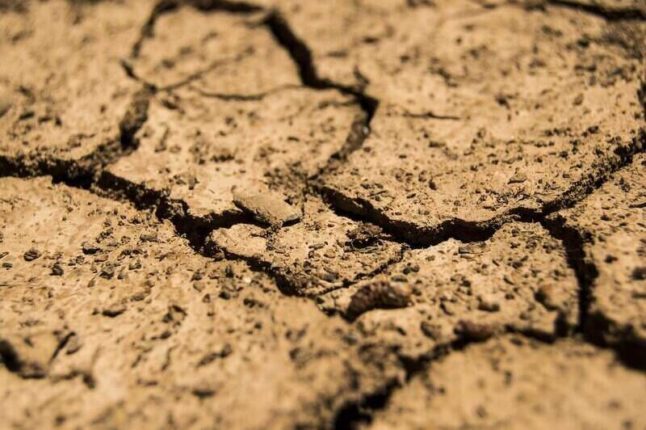
Fine clay particles make up a heavy, sticky soil structure with few air spaces between mineral particles. Think of clay soil as pretty much the same thing as the clay you would use to make art. Just like clay artworks become hard when they’re fired in a kiln, clay soil becomes rock hard if it’s allowed to dry out completely under the hot sun.
| Pros of Clay Soil | Cons of Clay Soil |
| ✓ Holds onto lots of plant nutrients ✓ Retains water for a long time | ✗ Poor drainage ✗ Becomes compacted very easily so that water and nutrients can’t reach plant roots ✗ Gets hard and cracks when it dries out ✗ Heavy and difficult to cultivate |
Best Plants for Clay Soil
Plants that thrive in heavy clay soil enjoy moisture and a tight texture around their roots or simply keep their root system shallow. The best-fitted beauties are:
- Canna lilies
- Bee balm
- Hibiscus
- Ferns
- Cardinal flowers
Best Vegetables for Clay Soil
Veggies that enjoy rich, heavy soil include:
- Lettuce
- Chard
- Brussels sprouts
- Pumpkins
We’re talking veggies with shallow roots that don’t need to fight the heavy clay for deeper rooting while also enjoying access to plenty of nutrients.
Best Grasses for Clay Soil
When choosing the right turf type to lay down on a clay lawn, consider:
- Tall fescue
- Kentucky bluegrass
- Perennial ryegrass
- Carpetgrass
They’re sturdy enough to face the heavy texture of clay soil and enjoy the rich nutrients.
How to Water Clay Soil
Water clay soil slowly to avoid puddling and leaching. Use rotary sprinkler heads or a drip irrigation system to give the ground enough time to absorb the drops. Apply water less often, only when the soil shows signs of dryness, to avoid overwatering.
Top Amendments for Clay Soils
Clay soil is heavy and tight on the roots, absorbs water slowly, and is prone to compaction. To improve its texture and make it a good soil for a variety of plants, amend with:
- Organic matter like compost, leaf mold, worm castings, grass clippings, bark, sawdust, and wood chips (the best option).
- Gypsum to break the tight clay into small crumbly pieces and improve drainage.
- Mulch to reduce soil crust formation.
- Groundcovers to limit soil compaction and improve water absorption and drainage.
Like silty soil, clay soil also compacts easily and requires periodic aeration. Clay soil is nutritious but hard to work with. A good strategy for planting species not suitable for heavy soils in a clay garden is to build raised beds.
4. Loamy Soil
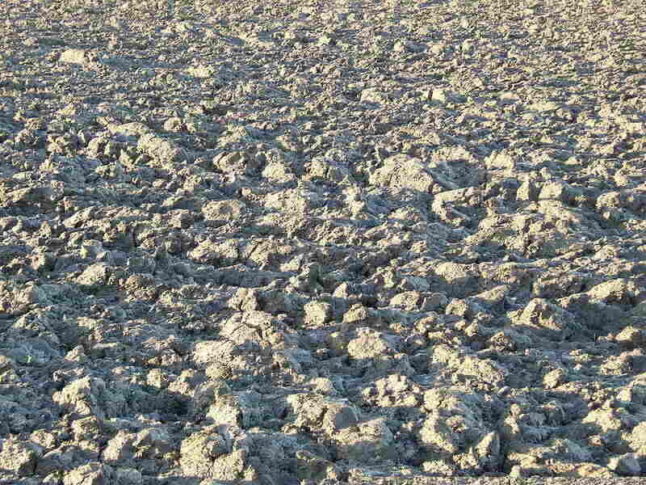
Loamy soil, also known simply as loam, is the ideal soil type. Loamy soil is a balanced mix of sand, silt, and clay particles that combines all their strengths. Loam is typically dark brown, almost black, and feels damp to the touch.
| Pros of Loamy Soil | Cons of Loamy Soil |
| ✓ Holds moisture and nutrients ✓ Good drainage ✓ Warms up quickly in spring, so plants start growing earlier ✓ Easy to cultivate | ✗ Somewhat susceptible to erosion |
Best Plants for Loamy Soil
Most plants will grow well in loam, which is the best soil type overall. Here are a few examples of plants that prefer it to other soil types:
- Wisteria
- Larkspurs
- American beauty-berry
- Hydrangeas
Best Vegetables for Loamy Soil
Most veggies and fruits grow well on loamy soil, but a few veggies especially love it, such as:
- Peppers
- Tomatoes
- Cucumbers
- Green beans
- Zucchini
Best Grasses for Loamy Soil
Loamy soil is also suitable for most turf types. With a loamy yard, you can plant all the popular turf types:
- Bermudagrass
- Zoysiagrass
- St. Augustine
- Fine Fescues
- Tall Fescues
- Perennial Rye
However, keep in mind turf grasses love loose, aerated soil, with good drainage. If your loam tends to go clayey or silty or has a tendency to compact, consider aerating and adding soil amendments to keep it light.
How to Water Loamy Soil
Loamy soil has good water-holding abilities. Irrigating your lawn and garden beds deeply and less often is the best strategy.
Top Amendments for Loamy Soil
While the closest to perfection, loamy soil still benefits from regular care. Use:
- Organic matter (compost, aged manure) to keep it fertile
- Mulch to protect it from compaction
- Groundcovers to keep the topsoil aerated and support a healthy microbiome.
5. Peat Soil
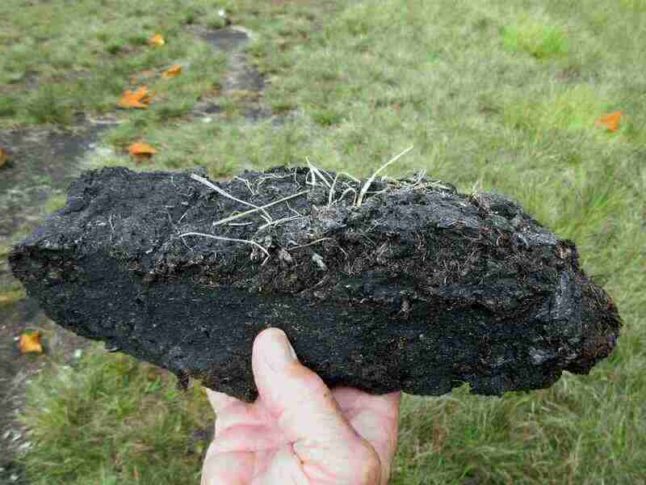
Peat soil isn’t common in home gardens. It’s made primarily of peat, which is organic matter that comes from decayed moss. You should only find peat soil near peat bogs or wetland areas. Peat soil feels spongy to the touch.
| Pros of Peat Soil | Cons of Peat Soil |
| ✓ Rich in organic matter ✓ Retains a large amount of water for a long time | ✗ Doesn’t drain well ✗ Poor in plant nutrients ✗ Too acidic for many plants |
Best Plants for Peat Soil
You’ll often find peat soil in plant containers, offering a good growing base for species like:
- Azaleas
- Camellias
- Blueberries
- Magnolias
- Caladiums
Best Vegetables for Peat Soil
In a well-drained, light peat soil you can grow:
- Potatoes
- Pumpkins
- Beans
- Sweet corn
Keep in mind peat soil is acidic and you need to raise soil pH by amending with lime to improve yield.
Best Grasses to Grow in Peat Soil
This type of soil is acidic, so you’ll need to go for grass types that can grow in a low pH environment such as:
- Carpetgrass
- Tall fescue
- Creeping bentgrass
- Colonial bentgrass
- Sheep’s fescue
- Hard fescue
How to Water Peat Soil
This type of soil holds water very well, like a sponge, so it’s easy to overwater plants. Before adding water, insert your finger into the soil about 2 to 3 inches deep. If it’s dry, irrigate. If it’s still moist or wet, wait a few more days, then test again.
Top Amendments for Peat Soil
Peat soil is acidic, with a pH of 3.7 to 5.2, prone to compaction, and poor in nutrients available to plants. When amending, focus on raising the pH (it will make nutrients more easily available to plants) and improving drainage. Use:
- Lime – raises the soil’s acidic pH and improves drainage
- Perlite – improves texture and drainage
- Rock phosphate – a good source of phosphorus, it helps plants access nutrients more easily.
Frequent aeration is necessary to improve oxygen content and drainage.
6. Chalky Soil
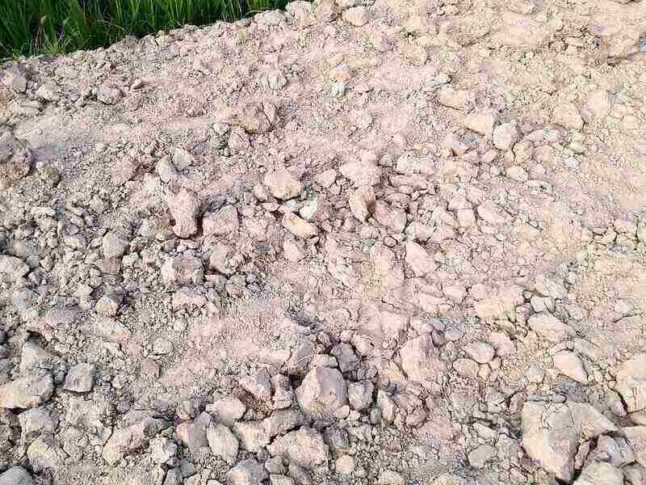
Chalky soil is found on top of limestone deposits deep beneath the Earth’s surface. Therefore, chalky soil is found only in certain areas and isn’t common. All chalky soils contain a lot of calcium carbonate, which makes them highly alkaline. Chalky soils have a stony texture and sometimes contain large, white lumps.
| Pros of Chalky Soil | Cons of Chalky Soil |
| ✓ Good drainage | ✗ Doesn’t retain moisture or plant nutrients ✗ Highly alkaline soil is bad for many plants ✗ Breaks down soil amendments, such as compost, very quickly. |
Best Plants for Chalky Soil
Plants that grow in chalky soil have a good tolerance for alkaline pH and drought. Among the most common you can choose from are:
- Ceanothus
- Bellflowers
- Clematis
- Dianthus
- Lavender
Best Vegetables for Chalky Soil
According to the University of Nebraska, some veggies that can adapt to the alkaline profile of chalk soil are:
- Asparagus
- Tomatoes
- Sweet corn
- Pumpkins.
Best Grasses for Chalky Soil
As for turf-type grasses, you need species that can tolerate higher soil pH and are better suited for chalky lawns, such as:
- Bermudagrass
- St. Augustine grass
- Buffalograss
- Blue grama
How to Water Chalky Soils
Chalky soils come with good drainage and low water-holding abilities. You’ll need to water more often and in smaller amounts, similar to sandy soil, to keep moisture available at the root level.
Top Amendments for Chalky Soil
Focus on improving the soil’s water-holding abilities and increasing nutrient content. The best amendments to use are:
- Organic mulch to slow water absorption, reduce evaporation, and release nutrients in time.
- Organic matter (compost, manure, leaf mold, pine needles, etc.) to improve texture and nutrient content.
- Green manure, such as crimson clover and vetch, is used to fix nitrogen in the soil.
- Fertilize with iron, manganese, and magnesium. Ask your lawn care professional for the best products to use on chalky soil.
How to Identify Your Soil Type
If you can’t identify your soil based on how it looks and feels alone, there are some tests that can help you figure it out.
Note: Soil can vary in spots, even a few feet apart. Always test the soil in the specific site you’re preparing for plants. Don’t assume the results of one test represent your whole property.
Professional Soil Test
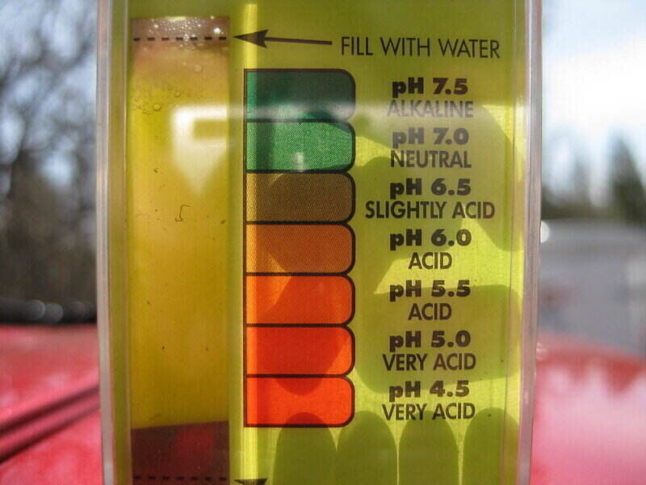
The best option is to take a soil sample and send it to a lab for a professional soil test. A professional soil test will not only tell you about your soil type. It also includes an analysis of your soil’s pH and the plant nutrients it contains, both of which are important for figuring out what help your soil needs and which plants you should grow.
Most professional soil tests will even tell you exactly what you can add to your soil to improve it, so you won’t have to figure out that part on your own.
You can usually get a soil test from your local university extension. For more information, find your extension using the National Institute of Food and Agriculture’s university directory.
DIY Ribbon Test
One simple soil identification test you can do from home is called the ribbon test. It will give you a good idea of your soil type/texture, but it won’t tell you about your soil’s other important characteristics, such as soil pH level and nutrient content.
Essentially, the point of the ribbon test is to see how well your soil holds together. Start by making a ball of moist soil about 1/2 – 3/4 inch in diameter.
Hold the ball between your thumb and forefinger and squeeze it into a flat “ribbon” shape. Continue squeezing, causing the ribbon to grow longer and longer until the soil breaks off.
This video from the University of Nebraska-Lincoln shows how to conduct your own soil ribbon test:
Once you have your soil ribbon, measure how long it is. The length of the soil ribbon will give you a good idea of what type of soil you have (check the chart below for details).
| Ribbon Length | Soil Type |
| No ribbon | Sandy soil |
| Less than 1-inch | Loam, sandy loam, or silty soil |
| 1 – 2 inches | Clay loam, sandy clay loam, or silty clay loam soil |
| Greater than 2 inches | Clay, sandy clay, or silty clay soil |
DIY Jar Test
Also known as “the settle test” this is another DIY method for identifying your soil type. It shows how your soil’s particles settle in water.
To perform this test:
- Take a handful of your soil and put it in any transparent container (Tupperware, Mason jar, anything will do).
- Pour water over the soil, leaving enough empty space in the container that you can shake up its contents.
- Shake well and leave it alone for at least 12 hours.
When you check on the container after 12 hours, the soil particles will have settled, and how they settled is a clue to your soil type. See the chart below to interpret your results.
| What You See in the Container | Soil Type |
| Water is mostly clear, and all the soil has collected at the bottom of the container | Sandy soil |
| Water is murky, and some of the soil forms a layer at the bottom of the container | Clay soil, silty soil, or a combination of the two |
| Water is mostly clear, and you can see separate layers of different-sized particles at the bottom of the container | Loam, clay loam, sandy loam, or another loam variation |
| Water is murky, many particles float on the water’s surface, and some soil has sunk to the bottom of the container | Peat soil |
| Water is a pale gray color with white, gritty pieces in it | Chalky soil |
This video from Urban Self Sufficiency explains the settle test a little more in-depth and helps you determine the exact combination of particles that makes the soil in your yard.
Use the results from your jar test and the soil pyramid chart below to figure out what kind of soil you have:
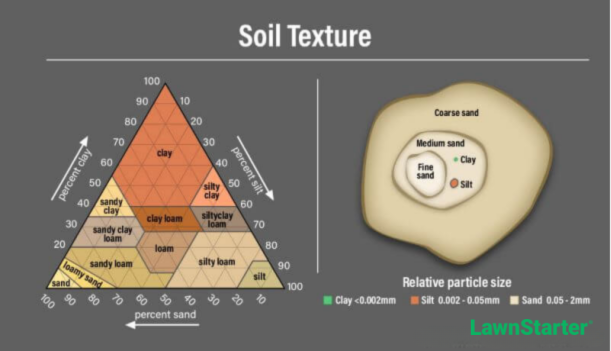
Acidic or Alkaline Soil
pH measures the alkalinity or acidity of soil and ranges from 0 (extremely acidic) to 14 (extremely alkaline). Depending on the soil pH, your yard can have:
- Alkaline soil (pH over 7.5): chalky soil, most clay soils
- Neutral soil (pH between 6.3 and 7.4): generally loamy and silty soils
- Acid soil (pH between 5.5 and 6.3): most sandy soils
- Strongly acidic soils (pH under 5.5): peat soil
Alkaline soil limits iron absorption, often leading to iron chlorosis. On the other hand, soil that is too acidic can release high amounts of zinc, aluminum, and manganese, which are toxic to plants.
Most plants (but not all) thrive in neutral to slightly acidic soil with a pH of 6 to 7 where their roots have easy access to essential nutrients like:
- Nitrogen
- Potassium
- Phosphorus
- Calcium
- Magnesium
You can test the soil pH at home or send a sample to the local Extension Office for a lab test. We have a detailed guide on soil pH you can read to learn how to take a soil sample for a precise pH test.
How to Correct Soil pH
In order to raise the pH of acidic soil, use lime. Soil alkalinity can be reduced by amending with sulfur-based materials or sphagnum peat moss.
Adding compost, manure, and other types of organic matter also can help tweak acidic and alkaline pH toward being neutral.
Changing soil pH is complex work, so it’s usually better to call a professional for this type of soil treatment.
FAQ About Soil Types
How Many Types of Soil Are There?
No two sites have the exact same soil composition, so really, there are infinite soil types. Every soil is a combination of the six basic textures described in this article, and the possible combinations are endless. You could call your soil “sandy soil” if it contains a majority of sand particles or “clay soil” if it contains mostly clay, and so on.
What Is Topsoil?
Topsoil is exactly what it sounds like – the topmost layer of the soil. The topsoil layer extends anywhere from 2 to 12 inches below the surface. This is the most important soil layer for gardening. It’s where your plants’ roots grow, where plant nutrients are found, and where beneficial microorganisms such as earthworms and bacteria live.
What Is a Soil Layer?
Soil layers, also known as soil horizons, are the different sections of soil extending from the surface (the topsoil) down into the Earth. Each layer has a designated letter and name to identify it.
These are the soil layers in order, from top to bottom:
- O horizon: Humus, a thin layer of decomposing organic materials (such as fallen leaves) that may or may not be present on top of the soil.
- A horizon: Topsoil, the layer of rock particles and organic matter that you work with when gardening.
- E horizon: Eluviated layer, a layer that contains no clay or organic matter but only sand or silt particles, which is only found in some soils.
- B horizon: Subsoil, a layer rich in minerals, where plant roots will extend if they’re allowed to grow and spread for a long time without being disturbed.
- C horizon: Parent material, the original material from which the soil developed, such as granite, limestone, or quartzite.
- R horizon: Bedrock, the mass of rock below the soil.
What Is Soil Erosion?
Soil erosion is the process of natural forces (such as wind and rain) weathering away the topsoil. Erosion may happen gradually over time, in which case you probably won’t even notice it. The time to worry is when erosion happens rapidly and carries all of your topsoil away, along with your soil’s fertility and ability to support plant life.
Improve Your Soil for a Healthier Lawn and Garden
Even if your soil test shows less than favorable results, don’t give up on having a landscape full of thriving greenery! You can work soil amendments into the ground to improve its overall fertility or make it more suitable for your plants.
If it gets complicated, we’re here to help! LawnStarter connects you with the best local landscaping pros with expertise in handling the different soil types in your area.
Don’t stop there! Use the LawnStarter website or app and hire a pro to handle routine mowing, yard cleaning, fertilization, aeration, and other outdoor tasks you’d love to take off your to-do list.
Main Photo Credit: Pixabay